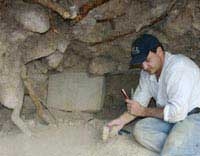The head of a marble statue was discovered last month amid the ruins of a second-century theater in Konuralp, northwestern Turkey, near the city of Düzce.
Experts have stated that the marble head of the statue of Alexander the Great unearthed in Turkey demonstrates the enduring fame of the ancient ruler, centuries after his death.
This artifact was found among the ruins of the upper levels of a Roman theater in Konuralp, north of Düzce, and near the northwestern coast of Turkey. It is believed to date back to the second century. Alexander the Great died in 323 BC, suggesting that the statue was likely created over 400 years after his passing.
Other remnants of marble statues, including the head of the Greek god Apollo and the mythical monster Medusa, were also discovered in the theater’s ruins, according to the Düzce municipal authorities in Turkey.

A white marble bust of Alexander the Great, severed at the neck, lying on the ground amid the rubble. (Image source: Düzce Municipality).
Alexander the Great remains a prominent figure in the ancient world long after his premature death at the age of 32 in Babylon near the Euphrates River, noted historian Paul Cartledge, a professor at the University of Cambridge and author of “Alexander the Great: The Hunt for a New Past” (Overlook Press, 2004).
One reason for Alexander’s lasting fame is that his successors elevated him as an ideal ruler they aspired to emulate. Cartledge, who was not involved in the new discovery, mentioned: “Those vying for the throne in his empire used his name.”
Subsequent rulers produced coins bearing Alexander’s image as a way to legitimize their reigns.
The Notorious Ruler
Experts noted that the marble head exhibits distinctive features compared to other representations of Alexander the Great, including a lion-like mane and upward-looking eyes. After analyzing the marble head, historians concluded it was a portrait of Alexander.
Alexander is one of the most famous rulers of the ancient world. Born in 356 BC, he became king of Macedonia, a territory north of Greece, in 336. His father, Philip II of Macedon, successfully united Greece under his rule.
Although not ethnically Greek, Alexander was fascinated by Greek culture and spread it as he embarked on military conquests to the south and east, culminating in his defeat of the powerful Persian Empire in a series of battles from 334 BC to 331 BC.
At its peak, Alexander’s empire stretched from Greece and Egypt to Bactria, nearly in the area now known as Afghanistan, and to Punjab in present-day Pakistan. However, his army refused to advance further, and Alexander returned to Babylon, where he died a few years later—possibly from illness, but also possibly from excessive drinking or poisoning.
When the Romans conquered much of the ancient world—including the kingdom of Bithynia, where the new statue was found—they also viewed Alexander the Great as an ideal ruler.
Alexander’s Shaving Habit—in contrast to the bearded appearance favored by most rulers before him—had a significant influence on Roman emperors, leading them to adopt the practice of shaving, as it was seen as the proper conduct for rulers. Alexander seemingly adopted this habit to be seen as resembling the Greek god Apollo, who was depicted without facial hair.





















































